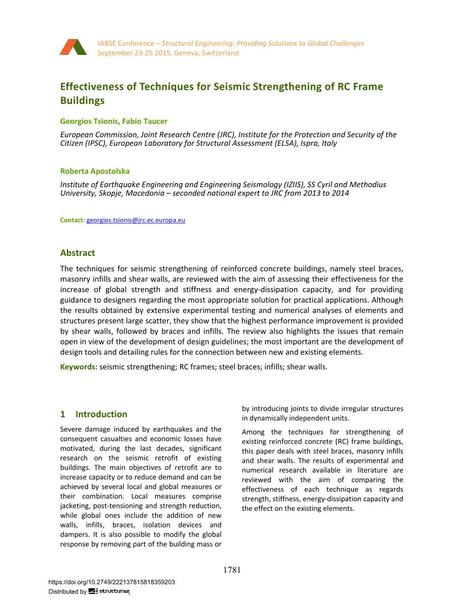Effectiveness of Techniques for Seismic Strengthening of RC Frame Buildings

|
|
|||||||||||
Détails bibliographiques
| Auteur(s): |
Georgios Tsionis
(European Commission, Joint Research Centre (JRC), Institute for the Protection and Security of the Citizen (IPSC), European Laboratory for Structural Assessment (ELSA), Ispra, Italy)
Roberta Apostolska (Institute of Earthquake Engineering and Engineering Seismology (IZIIS), SS Cyril and Methodius University, Skopje, Macedonia – seconded national expert to JRC from 2013 to 2014) Fabio Taucer (European Commission, Joint Research Centre (JRC), Institute for the Protection and Security of the Citizen (IPSC), European Laboratory for Structural Assessment (ELSA), Ispra, Italy) |
||||
|---|---|---|---|---|---|
| Médium: | papier de conférence | ||||
| Langue(s): | anglais | ||||
| Conférence: | IABSE Conference: Structural Engineering: Providing Solutions to Global Challenges, Geneva, Switzerland, September 2015 | ||||
| Publié dans: | IABSE Conference Geneva 2015 | ||||
|
|||||
| Page(s): | 1781-1788 | ||||
| Nombre total de pages (du PDF): | 8 | ||||
| Année: | 2015 | ||||
| DOI: | 10.2749/222137815818359203 | ||||
| Abstrait: |
The techniques for seismic strengthening of reinforced concrete buildings, namely steel braces, masonry infills and shear walls, are reviewed with the aim of assessing their effectiveness for the increase of global strength and stiffness and energy-dissipation capacity, and for providing guidance to designers regarding the most appropriate solution for practical applications. Although the results obtained by extensive experimental testing and numerical analyses of elements and structures present large scatter, they show that the highest performance improvement is provided by shear walls, followed by braces and infills. The review also highlights the issues that remain open in view of the development of design guidelines; the most important are the development of design tools and detailing rules for the connection between new and existing elements. |
||||
